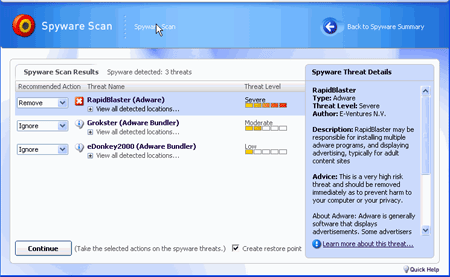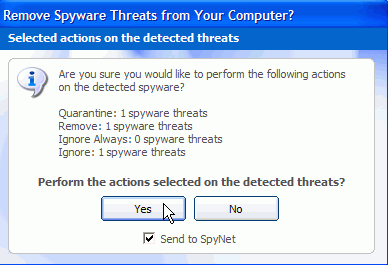CPU usage hovered between 50% and 80% typically during our tests, with memory usage pegged in
the mid 20MB range. This makes it a bit more processor and memory intensive that
Ad-Aware SE, but not by much. As you would anticipate from scanning software,
the Microsoft Windows AntiSpyware (beta) program did a pretty good job of making our
computer temporarily resemble molasses, but no more than any other spyware or
virus scanner we have tested.

Finishing the scan takes you to
the spyware scan results window, which was probably our favourite
component of the software from a usage perspective. The detected spyware/adware/malware applications are
arranged and graded by threat level in the left hand window, each with
a drop down box indicating the action that should be taken for them (the
default setting of this box is the antispyware program's recommended setting).
Users can open a 'view all
detected locations' tree for each entry which expands to show you all detected
files and registry entries for that particular piece of nastiness. On the right
hand side is an information window which provides some basic information on the
highlighted entry, including its author and the trouble it can cause.
We loved the way the spyware scan results window was laid out. In
comparison to Ad-Aware SE or Spybot, well... There is no comparison. The
Microsoft antispyware software, even in beta is much more user friendly and this
should contribute to helping novice users feel confident about finding and
deleting spyware. As a nice touch, a check box on the bottom of the screen
allows Windows XP users to create a system restore point before taking any other
actions.
Clicking the 'continue' button gives you a summary of the actions the
Microsoft Antispyware software is about to take. Confirming this sends
information to SpyNet (if enabled) then cleans the offending software off your
system.

One thing that we noted is that this Microsoft beta does not seem to be as
effective as Ad-Aware in finding the various 'tracking cookies' that websites
might leave on your system. The software seems to pretty much ignore these
completely.
As a side note, any doubt that Microsoft was using GIANT's technology pretty
much unchanged was dispelled by the fact that the software shows up as
'GIANTAntispywareMAIN.exe' in process manager.
